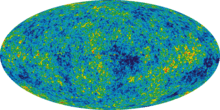Three-torus model of the universe

The three-torus model of the universe, or informally doughnut theory of the universe, is a proposed model describing the shape of the universe as a three-dimensional torus. The name comes from the shape of a doughnut, whose surface has the topology of a two-dimensional torus.
Supporting evidence
Alexi Starobinski and Yakov B. Zeldovich proposed the model in 1984 from the Landau Institute in Moscow; however, the basis for his theory began much earlier than 1984.[1] The foundation for any knowledge of the shape of the universe began in the mid-1960s with the discovery of cosmic microwave background (CMB) by Bell Labs. Greater understanding of the universe's CMB provided greater understanding of the universe's topology; therefore, in a quest for cosmic understanding, NASA supported two explorer satellites, the Cosmic Background Explorer (COBE) in 1989 and the Wilkinson Microwave Anisotropy Probe (WMAP) in 2001, which have gathered more information on CMB.
Cosmic Background Explorer (COBE)
The Cosmic Background Explorer was an explorer satellite launched in 1989 by NASA that used a Far Infrared Absolute Spectrometer (FIRAS) to measure the radiation of the universe.[2] Led by researchers John C. Mather and George Smoot, COBE was able to obtain precise readings of radiation frequencies across the universe. With data on the universe’s radiation distribution, Mather and Smoot discovered small discrepancies in temperature fluctuation known as anisotropies throughout the universe. The finding of anisotropies led Mather and Smoot to conclude the universe consists of regions of varying densities. In the early stages of the universe, these denser regions of the cosmos were responsible for attracting the matter that ultimately became galaxies and solar systems. In “Microwave Background Anisotropy in a Toroidal Universe” by Daniel Stevens, Douglas Scott, and Joseph Silk of University of California Berkeley, the cosmologists proposed the isotropic universe suggests a complicated geometric structure. The researchers argued the density fluctuations reported by COBE proved “multiply connected universes are possible, [and] the simplest [and most probable multiply connected universe] is the three-dimensional torus.” Additionally, the journal concludes a torus shaped universe is compatible with COBE data if the diameter of the torus' tube is at least 80% greater than the torus’ horizontal diameter.[3] Thus, COBE provided researchers with the first concrete evidence for a torus-shaped universe. COBE was eventually decommissioned by NASA on December 23, 1993.[2]
Wilkinson Microwave Anisotropy Probe (WMAP)

The Wilkinson Microwave Anisotropy Probe (WMAP) was launched in 2001 as NASA’s second explorer satellite intended to map the precise distribution of CMB across the universe. Improving on the design of COBE, WMAP was able to represent an extremely accurate, fine resolution map of the CMB.[4] Analysis by Max Tegmark, Angélica de Oliveira-Costa, and Andrew J. S. Hamilton of University of Colorado provided fresh evidence supporting a torus-shaped universe.[5] After eliminating the radiation from stars and our own galaxy, the CMB of the universe appears more concentrated (intense) across one plane of the universe than all others. This concentration of CMB forms a straight line in the universe and may indicate a compact, finite universe.[n 1]
Tegmark proposes his explanation, to his co-written study, that the universe is finite - the amount of radiation in one area is limited to and thus indicative of the size of the area in that direction. Where radiation exceeds its quota for the size of the plane seen, the universe has overflowed in that direction creating a plane in other directions. The perpendicular to the direction of the plane may thereby have created an invisible loop of a torus. Therefore, Tegmark suggests a torus geometry is the most probable shape consistent with his analysis of WMAP CMB maps.[1][5]
See also
Notes and references
- Notes
- ↑ Note, however, such a self-consistent entity does not negate the possibility of an infinite universe or alternatively finite super-universe which is capable of containing such an entity. A parallel can be made to the shape of the bulk of the Milky Way in the night sky.
- References
- 1 2 Overbeye, Dennis. New York Times 11 March 2003: Web. 16 January 2011. “Universe as Doughnut: New Data, New Debate”
- 1 2 Smoot, George. Encyclopedia of Astronomy and Astrophysics. Brunel Road, UK: Institute of Physics Publishing, 2001. Web 28 Jan. 2011. “Cosmic Background Explorer: COBE”
- ↑ Stevens, Daniel. Douglas, Scott. Joseph, Silk. Phys. Rev. Lett. 71 (1993): Web. January 24, 2011. “Microwave Background Anisotropy in a Toroidal Universe”
- ↑ Griswold, Britt. Edward J. Wollack. nasa.gov. NASA, 29 Oct. 2010 Web. 2 Feb. 2011. “Wilkinson Microwave Anisotropy Probe”
- 1 2 Tegmark, M., A. de Oliveira-Costa, & A. J. S. Hamilton, 2003. Physical Review D. “A high resolution foreground cleaned CMB map from WMAP”.